SOVIET ARMY SETS STAGE FOR 1945 ASSAULT ON BERLIN
East Prussia, Germany • October 16, 1944
In the summer of 1944 Adolf Hitler’s Nazi Germany was knocked off balance by one-two punches delivered almost simultaneously by the Western Allies’ invasion of Northwestern France, codenamed Operation Overlord (June–August 1944), and the Soviet Union’s offensive, Operation Bagration (June–August 1944), which began with the reconquest of Belorussia (Belarus), a Soviet Socialist Republic sandwiched between Russia and German-occupied Poland. On October 1, 1944, Soviet armed forces in the form of the Third Belorussian Front, under the command of Gen. Ivan Chernyakhovsky, stood on the border between the former Baltic state of Lithuania and East Prussia (see map below), the first province of the German homeland to be threatened by an Allied invasion.
The Soviet Union and its predecessor, Czarist Russia, had long regarded East Prussia as the lair of German militarism, the stronghold of wealthy Prussian Junkers, a military aristocracy that owned vast estates there. Many of the top commanders in Kaiser Wilhelm II’s army came from East Prussia and were Junkers (e.g., World War I hero Field Marshal Paul von Hindenberg), and with the formation of Hitler’s Wehrmacht (unified army, navy, and air force) in 1935, most of the German high command during the interwar and war years was staffed by Prussian militarists; e.g., Adm. Karl Doenitz of the German Kriegsmarine; Field Marshal Walther von Brauchitsch, Supreme Commander of the German Army; and Field Marshals Gerd von Rundstedt and Erich von Manstein. During the opening salvos of Operation Barbarossa, Hitler’s June 1941 stab-in-the-back attack of his erstwhile ally, the Soviet Union, East Prussia was the jumping off point for Field Marshal Wilhelm Ritter von Leeb’s Army Group North’s drive on, and subsequent deadly 872‑day siege and bombardment of, Leningrad, the Soviet Union’s East Baltic port and second largest city.
The capital of East Prussia was the Baltic seaport of Koenigsberg (today’s Kaliningrad, Russia), a city of 372,164 people (1939 census). At the start of October 1944, the Third Belorussian Front was roughly 130 miles/209 km east of Koenigsberg. By mid-month, after a slow advance of some 30 miles/48 km, the time had come to launch Gumbinnen Operation (aka Goldap Operation), the attack on East Prussia. So on this date, October 16, 1944, Chernyakhovsky’s army took the offensive, and the next day had penetrated the German border 34 miles/55 km northwest of Gumbinnen (Gusev). Soviet fighter bombers and heavy tanks nearly destroyed the town. East Prussian defenses were unexpectedly tough, though. Five days later the Soviet advance had come to a standstill. By early November, after a half-dozen major give-and-take clashes by both sides weakened by combat and facing the onset of winter, the opposing forces dug in, the Third Belorussian Front holding its booty of a 25‑mile/40 km‑deep by 90‑mile/145 km‑wide foothold within the Reich. Simply put, however, Gumbinnen Operation went down in the records book as a Soviet defeat.
On January 12, 1945, a rejuvenated Third Belorussian Front re-engaged the enemy. A major part of the new East Prussian offensive was the Koenigsberg Offensive, or Battle of Koenigsberg, which ended on April 9 after a 4‑day final assault (see photo essay). The offensive that destroyed the seat of German militarism and fascism and set the stage for the Battle of Berlin in April 1945 was one of the bloodiest on German soil. It was fueled on the one hand by the Red Army’s thirst for vengeance after the Wehrmacht had occupied Mother Russia for 3 terror-filled years, committing numberless atrocities against soldiers and civilians alike (e.g., 1.5 million killed in Leningrad, close to 480,000 in Stalingrad), and on the other by East Prussian units of the regular armed forces, 5,000 men of the Volkssturm consisting of boys and the elderly, and local Hitler Youth who served themselves up as cannon fodder in the dying days of the Third Reich.
Forlorn Battles: East Prussia 1944–1945
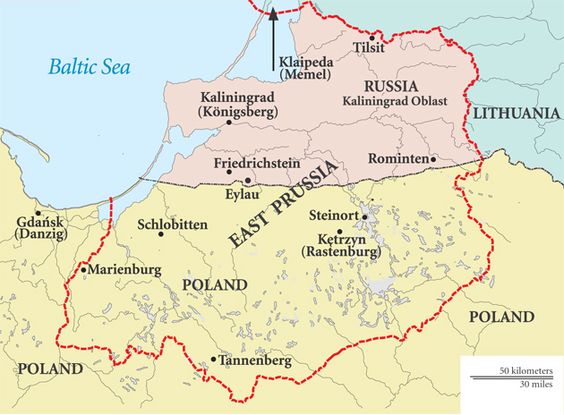 |
Above: East Prussia (German, Ostpreussen) was the heart of the old Prussian kingdom of Brandenburg-Prussia. The boundaries of this province remained unchanged until World War I. Its area was then 14,284 sq. miles/36,995 sq. km, and its population in 1910 was 2,064,175 and largely (83 percent) Lutheran. After World War II, East Prussia was partitioned between Poland (the southern part) and the Soviet Union (the northern part). With the exception of the Klaipėda (Memel) territory, which was reincorporated into Lithuania, the northern half of East Prussia, an area about half the size of Belgium, was officially incorporated into the Soviet Union in July 1946 and colonized by Russians beginning the same year. Koenigsberg became Kaliningrad. In the southern half about 400,000 indigenous Poles remained, and immigrants from prewar Poland replaced ethnic Germans, who were either killed in the conflict, had fled or perished in advance of the Red Army in the harsh winter of 1944–1945, or were expelled in an action euphemistically referred to as “population transfer” several years after combat ended in May 1945. Expulsion was the better option because the occupying Red Army, in an echo of what the people of Leningrad had had to endure when the Germans besieged their city, made no attempt to supply the German survivors with provisions. The denizens of Koenigsberg lived on the verge of starvation and privation of every kind, amid unburied corpses, nonexistent sanitation, polluted water, and disease.
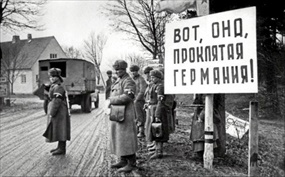 | 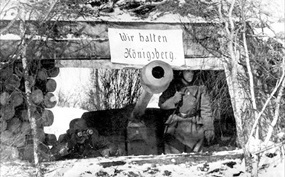 |
Left: At the close of Operation Bagration in late August 1944 the Red Army had reached the Lithuanian-East Prussian border, ready to bring the ground war to the first province in Germany proper. There soldiers erected a large signboard that read: “That’s it, damn Germany.”
![]()
Right: Defiant German soldiers in the company of a tank wait for the Soviet onslaught, late December 1944 in East Prussia. The sign on their log bunker reads: “We will hold Koenigsberg.” The truth was, the defending Army Group Center (renamed Army Group North) was outnumbered 3‑to‑1 by the Red Army, which was well-armed and -equipped, with plentiful tanks, an overwhelming artillery arm consisting of small-caliber to self-propelled 122 mm, 203 mm and 305 mm guns, and complete control of the skies.
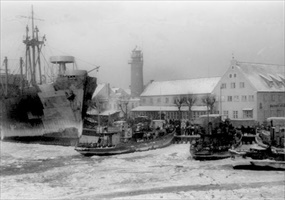 | 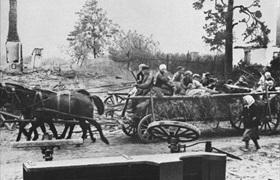 |
Above: Refugees from East Prussia fleeing west before the advancing Red Army in 1945. They fled, a good 450,000 between January and April 1945 by ship or small boats as seen in the left frame from the seaport of Pillau, which is now the Russian port of Baltiysk. Still others fled on foot or by wagon, some traversing an ice sheet, in appalling winter weather, with little or no food and no shelter except what they could find along the way. Thousands died from exposure or were killed during the evacuation. When Festung Koenigsberg’s garrison surrendered, military and civilian dead in the city were estimated at 42,000, with the Red Army claiming over 90,000 prisoners. About 120,000 survivors remained in the ruins of the devastated city. Comprising mostly women, children, and the elderly, plus a few others who had returned immediately after the fighting ceased, these survivors were held as slave laborers until 1949. The vast majority of German civilians remaining in Koenigsberg after 1945 died from disease or starvation, or in revenge-driven ethnic cleansing. The remaining 20,000 German residents were expelled by Soviet authorities in 1949–1950.
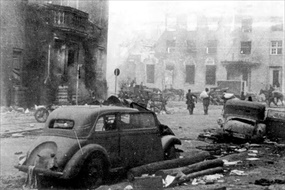 | 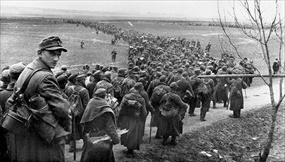 |
Left: By January 28, 1945, the first Red Army troops had reached the outskirts of Koenigsberg, overpowering local fortifications. At month’s end the fortress city was encircled, weighed down by 300,000 refugees. Still the garrison held off all Soviet assaults until April 6, when Soviet loudspeakers and the heaviest artillery, rocket, and aerial bombardment German soldiers on the Eastern Front had yet encountered began pounding in the last nails in the doomed fortress’s coffin. A pall of smoke and doom enveloped the city, whose population had been reduced to 130,000.
![]()
Right: Having already stormed parts of the city, by the night of April 8 Soviet fighters had captured one strongpoint after another till they held three-quarters of the city. The Koenigsberg garrison, by now hundreds of miles/kilometers to the rear of the main front line in the east, surrendered just before midnight the next day, April 9, after a siege of over 2 months. Tens of thousands of German soldiers like those shown in this photograph were marched to Soviet POW camps. Isolated German pockets held out along the Baltic coast—most would succumb by April 25—but East Prussia had already devolved into a minor theater of war, its place overtaken in mid-April by the climactic Battle of Berlin.
Soviet Assault on East Prussia, October 1944 to April 1945
![]()

 History buffs, there is good news! The Daily Chronicles of World War II is now available as an ebook for $4.99 on Amazon.com. Containing a year’s worth of dated entries from this website, the ebook brings the story of this tumultuous era to life in a compelling, authoritative, and succinct manner. Featuring inventive navigation aids, the ebook enables readers to instantly move forward or backward by month and date to different dated entries. Simple and elegant! Click
History buffs, there is good news! The Daily Chronicles of World War II is now available as an ebook for $4.99 on Amazon.com. Containing a year’s worth of dated entries from this website, the ebook brings the story of this tumultuous era to life in a compelling, authoritative, and succinct manner. Featuring inventive navigation aids, the ebook enables readers to instantly move forward or backward by month and date to different dated entries. Simple and elegant! Click 











